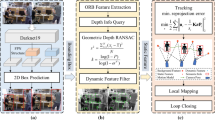Abstract
Inspired by the excellent navigational behavior of animals, this paper presents a bionic autonomous navigation (bio-navi) system by using a stereo camera and a polarization navigation sensor (POLNS). A topological graph consisting of nodes and edges forms the core of the system, which is similar to the simultaneous localization and mapping (SLAM). Like most of the SLAM approaches, in the bio-navi system, a node contains pose (position and attitude) and visual template information while an edge represents a constraint between two nodes. The difference is that the POLNS is introduced into the system. The yaw angle obtained from POLNS is attached to a node as a new property and also forms a new edge which restricts the direction of the related node. Besides, an absolute place constraint edge is added to the current node when recognizing a prior known place. To improve the accuracy and robustness of the place recognition, a POLNS-assist loop closure detection method is presented and to correct the pose error of constructed nodes, an improved graph optimization algorithm is derived in detail which is able to make full use of all the constraints. To demonstrate the performance of the system, an outdoor vehicle test has been done, and the results show its effectiveness and feasibility.








Similar content being viewed by others
References
Baird, E., Boeddeker, N., Ibbotson, M. R., & Srinivasan, M. V. (2013). A universal strategy for visually guided landing. Proceedings of the National Academy of Sciences, 110(46), 18686–18691.
Boal, J., Sánchez-Miralles, A., & Arranz, A. (2014). Topological simultaneous localization and mapping: A survey. Robotica, 32(05), 803–821.
Chu, J., Zhao, K., Zhang, Q., & Wang, T. (2008). Construction and performance test of a novel polarization sensor for navigation. Sensors and Actuators A: Physical, 148(1), 75–82.
Cochran, W. W., Mouritsen, H., & Wikelski, M. (2004). Migrating songbirds recalibrate their magnetic compass daily from twilight cues. Science, 304(5669), 405–408.
Collett, T. S., & Graham, P. (2004). Animal navigation: Path integration, visual landmarks and cognitive maps. Current Biology, 14(12), R475–R477.
Cummins, M., & Newman, P. (2008). FAB-MAP: Probabilistic localization and mapping in the space of appearance. The International Journal of Robotics Research, 27(6), 647–665.
Davison, A. J., Reid, I. D., Molton, N. D., & Stasse, O. (2007). MonoSLAM: Real-time single camera SLAM. IEEE Transactions on Pattern Analysis and Machine Intelligence, 29(6), 1052–1067.
Denuelle, A., & Srinivasan, M. V. (2015). Snapshot-based navigation for the guidance of UAS. In Australasian Conference on Robotics and Automation (ACRA 2015).
Diebel, J. (2006). Representing attitude: Euler angles, unit quaternions, and rotation vectors. Matrix, 58, 15–16.
Etienne, A. S., & Jeffery, K. J. (2004). Path integration in mammals. Hippocampus, 14(2), 180–192.
Gagliardo, A. (2013). Forty years of olfactory navigation in birds. The Journal of experimental biology, 216(12), 2165–2171.
Garratt, M. A., & Chahl, J. S. (2008). Vision-based terrain following for an unmanned rotorcraft. Journal of Field Robotics, 25(4), 284.
Geiger, A., Ziegler, J., & Stiller, C. (2011). Stereoscan: Dense 3D reconstruction in real-time. In 2011 IEEE, Intelligent Vehicles Symposium (IV) (pp. 963–968). IEEE.
Geva-Sagiv, M., Las, L., Yovel, Y., & Ulanovsky, N. (2015). Spatial cognition in bats and rats: From sensory acquisition to multiscale maps and navigation. Nature Reviews Neuroscience, 16(2), 94–108.
Grisetti, G., Kümmerle, R., Stachniss, C., & Burgard, W. (2010). A tutorial on graph-based SLAM. IEEE Intelligent Transportation Systems Magazine, 2(4), 31–43.
Kitt, B., Geiger, A., & Lategahn, H. (2010). Visual odometry based on stereo image sequences with ransac-based outlier rejection scheme. In 2010 IEEE Intelligent Vehicles Symposium (IV) (pp. 486–492). IEEE.
Lambrinos, D., Kobayashi, H., Pfeifer, R., Maris, M., Labhart, T., & Wehner, R. (1997). An autonomous agent navigating with a polarized light compass. Adaptive Behavior, 6(1), 131–161.
Lambrinos, D., Möller, R., Labhart, T., Pfeifer, R., & Wehner, R. (2000). A mobile robot employing insect strategies for navigation. Robotics and Autonomous Systems, 30(1), 39–64.
Lategahn, H., Geiger, A., & Kitt, B. (2011). Visual SLAM for autonomous ground vehicles. In 2011 IEEE International Conference on Robotics and Automation (ICRA) (pp. 1732–1737). IEEE.
Milford, M. J., & Wyeth, G. F. (2008). Mapping a suburb with a single camera using a biologically inspired SLAM system. IEEE Transactions on Robotics, 24(5), 1038–1053.
Muheim, R., Phillips, J. B., & Åkesson, S. (2006). Polarized light cues underlie compass calibration in migratory songbirds. Science, 313(5788), 837–839.
O’keefe, J., & Nadel, L. (1978). The hippocampus as a cognitive map (Vol. 3). Oxford: Clarendon Press.
Olson, E., Leonard, J., & Teller, S. (2006). Fast iterative alignment of pose graphs with poor initial estimates. In ICRA 2006, Proceedings 2006 IEEE International Conference on Robotics and Automation (pp. 2262–2269). IEEE.
Scaramuzza, D., & Fraundorfer, F. (2011). Visual odometry [tutorial]. IEEE Robotics & Automation Magazine, 18(4), 80–92.
Srinivasan, M. V., Chahl, J. S., Weber, K., Venkatesh, S., Nagle, M. G., & Zhang, S.-W. (1999). Robot navigation inspired by principles of insect vision. Robotics and Autonomous Systems, 26(2), 203–216.
Wang, Y., Hu, X., Lian, J., Zhang, L., Xian, Z., & Ma, T. (2014). Design of a device for sky light polarization measurements. Sensors, 14(8), 14916–14931.
Xian, Z., Hu, X., Lian, J., Zhang, L., Cao, J., Wang, Y., et al. (2014). A novel angle computation and calibration algorithm of bio-inspired sky-light polarization navigation sensor. Sensors, 14(9), 17068–17088.
Acknowledgments
This work was supported by the National Natural Science Foundation of China (Nos. 61503403, 61573371) and the National University of Defense Technology Advanced Research Programs (Nos. JC14-03-04, JC14-03-06). We thank Yujie Wang and Tao Ma for helpful discussions.
Author information
Authors and Affiliations
Corresponding author
Rights and permissions
About this article
Cite this article
Xian, Z., He, X., Lian, J. et al. A bionic autonomous navigation system by using polarization navigation sensor and stereo camera. Auton Robot 41, 1107–1118 (2017). https://doi.org/10.1007/s10514-016-9596-7
Received:
Accepted:
Published:
Issue Date:
DOI: https://doi.org/10.1007/s10514-016-9596-7




